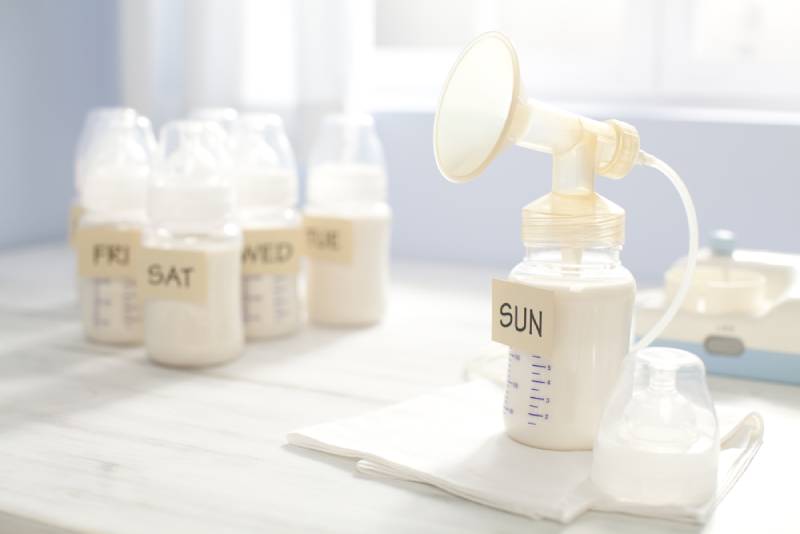Wondering how to stop pumping safely and make the weaning journey as easy as possible?
No worries, here you’ll find everything you need to know to help you safely (and slowly but surely) wean from the pump!
First of all, I’d like to congratulate all you pumping moms for your selfless minutes of pumping (and washing pump parts) so you could provide your little ones with precious nutrients and antibodies that are crucial for their health and happiness!
And now, the time has come. It’s time to figure out how to wean from the pump effectively and safely!
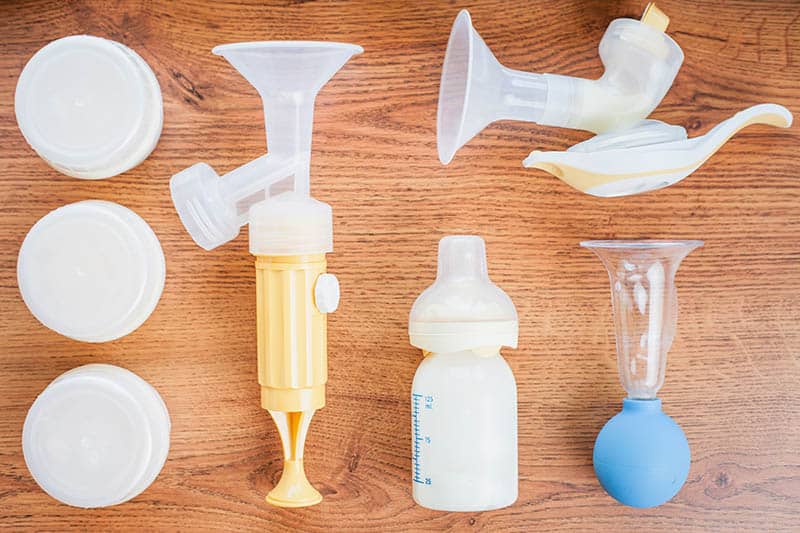
When it comes to successfully weaning yourself from the breast pump, the emphasis is on the word “safely” because if you stop cold turkey, you will be at risk of developing painful engorgement, clogged milk ducts and / or mastitis.
RELATED: How To Unclog Milk Ducts: 10 Best Strategies To Relieve Pain
And, we want to avoid all that, right?
We want to wean safely and trouble free! Before diving deeper into the matter, here are the answers to some questions that might interest you, so make sure to check them out.
How long does it take to completely wean from the pump?
This is probably one of the first things every mom weaning from the pump wants to know.
After all, it’s easier to start the process of weaning from the breast pump once you know approximately how long it will take.
And the answer is: 2-4 weeks. Yup, it takes around 2-4 weeks to completely wean from the pump and the process depends on many factors like:
• The number of your current daily pumping sessions
• Your baby’s age
• If you have an over or under milk supply
• Your lifestyle and work situation
• If you are susceptible to clogged milk ducts (or not).
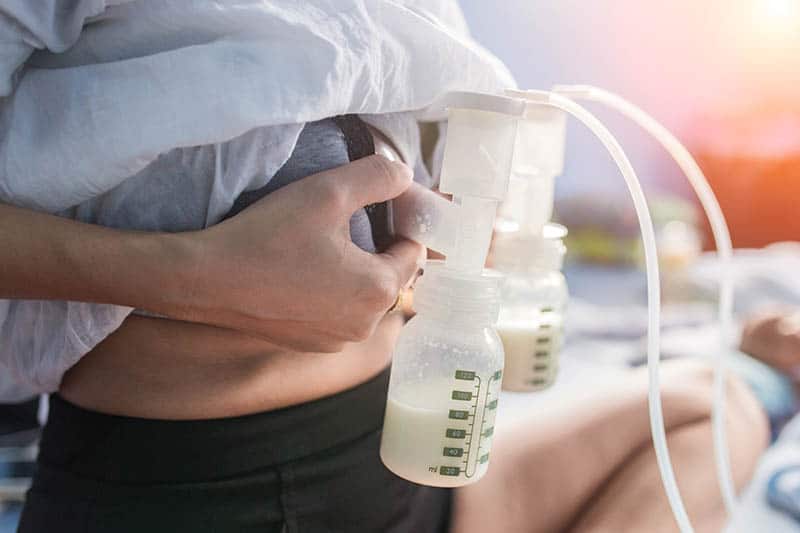
From all the factors above, I would like to highlight over or under milk supply and clogged milk ducts.
If you experience one of these issues (or both), it’s strongly advisable not to rush the pump weaning process.
Also, if you have a large oversupply, it will probably take you longer to completely wean from exclusive pumping. All in all, the best bet is taking it slow!
Are there any side effects once you stop pumping?
The American Academy of Pediatrics recommends you breastfeed your little one for at least one year.
Even though they recommend that babies are breastfed for a certain period of time, this is still an individual choice for every mom out there.
Every breastfeeding journey is a unique experience.
One of the best parts of pumping is not worrying whether you’ll have enough milk for the next day.
But, specific work schedules, medication (that doesn’t go well with nursing), and other factors might influence if the mother or the baby initiates the weaning process earlier than recommended (which is more than okay and understandable).
Now, the next thing every mom weaning from the pump wants to know is: Are there any side effects once you stop pumping?

And the answer is: Yes, there are side effects, but they are mostly short lived and it all depends on the pace you wean from the pumping process.
In other words: If you stop pumping slowly, the side effects will not be severe, but mild.
Once you start the process of weaning from the pump, the levels of your breastfeeding hormones (prolactin, relaxin, and oxytocin) will gradually start decreasing, or better said, they will start returning to their normal levels.
And, as that happens, you might experience the following side effects:
• Mood swings
• Headaches
• Nausea
• Feeling irritable, anxious, or depressed.
Nevertheless, it’s important to note that all the mentioned side effects are a natural occurrence and over time they will vanish into thin air.
If you’re wondering how long these symptoms will last, the answer is 2-4 weeks after you stop pumping.
Another potential side effect is weight gain. I deliberately added “potential” because not all moms necessarily experience it.

When I first heard about this one, my instant question was: How the hell can weight gain be linked with breast milk?
But, it can. When your body is actively making breast milk, it burns calories in the process.
So, logically, once you stop pumping, your body will stop burning calories and as a result, you might gain some weight.
This all depends on your eating habits and lifestyle, as well though.
If you eat far more than you can burn, you will gain weight. If you eat regular healthy portions, you should maintain your initial body weight and figure.
How to stop pumping breast milk
The process of weaning from pumping is similar to weaning from the breast.
Both are strongly recommended to be done slowly so that your breast milk supply decreases naturally and so that you avoid any type of potential discomfort.
And this is how you do it:
1. Gradually reduce your pumping sessions
Here the emphasis is on gradually.
If you don’t do it slowly, the side effects and discomfort might become severe, which could greatly influence your everyday life (especially time spent at work).
So, one of the ways to stop pumping is to gradually decrease your pumping sessions.
What does this mean?
If you usually pump 4 times per day, the goal is to eliminate one session so that you only pump 3 times per day for a few days.
After a few days, the next goal is to eliminate one more session so that you only pump 2 times per day.
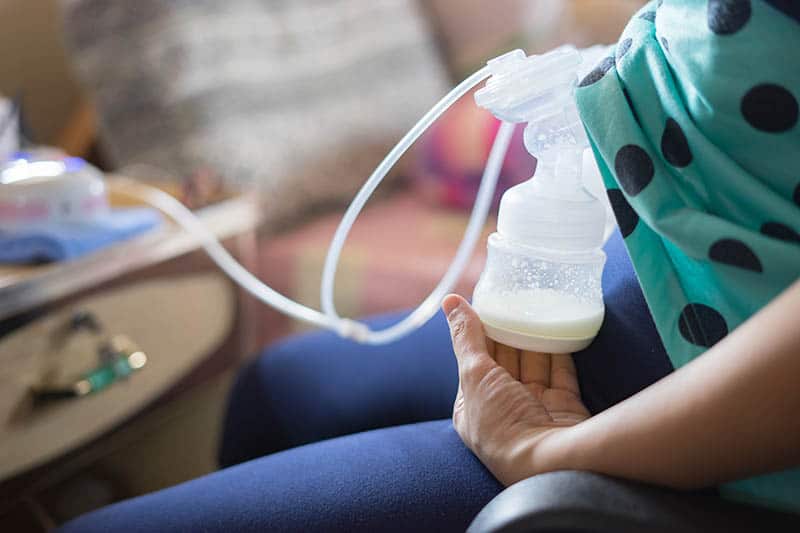
Then, after a few days, you will be left with 1 session after which you will have none.
This elimination process will eventually result in less breast milk production and allow you to completely wean yourself from the pump.
The gaps between eliminating sessions are very important.
You need to give your body (or better said boobs) some time to adjust to this new regimen.
When you think of eliminating one session every few days, it probably doesn’t sound like something drastic to you.
But, for your body it is.
Every small change can greatly influence how you feel and how your body reacts.
So, giving it some time to adjust to a decreased number of pumping sessions is extremely important for both your well being and successfully weaning from the pump.
2. Gradually reduce pumping time for all your daily sessions
Another way to safely wean from the pump is by gradually reducing pumping time for all your daily sessions.
As you can see, this one is pretty similar to the previous one.
The main difference between the two is that the previous method is about reducing the number of pumping sessions and this one is about reducing the pumping time of those sessions.
The principle is basically the same.

So, if your regular pumping time of one nursing session is 15 minutes, try reducing it by one to two minutes every other day or every few days.
Through time, your 15 minute session will decrease to 0 minutes with no milk to pump, which is the main goal.
Reducing one to two minutes is a regular speed, and it’s up to you to decide how many days you will pump at a certain speed.
You can always add more days for every reduction that you make.
All you need to do is listen to your body and act accordingly!
3. Gradually increase the length of time between your pumping sessions
If you’re wondering how to stop pumping, here’s another effective and safe way to safely wean from the pump.
This method requires increasing the amount of time between your pumping sessions.
At first, this might sound confusing, but I’ll try to explain it as simply as possible.
So, if you usually pump every 4 hours, try pumping every 4.5 hours for the first few days and then every 5 hours for another few days.
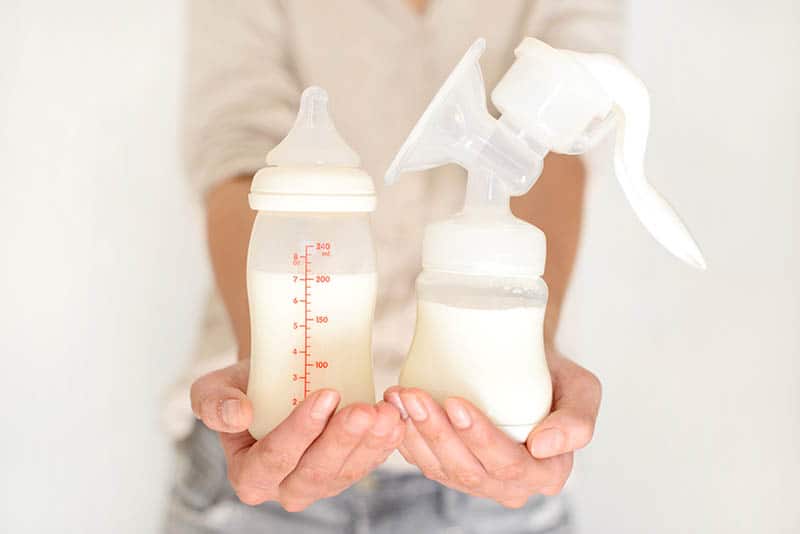
This method also works on the principle of a gradual decrease of supply and the only difference is that you’ll achieve it by increasing the amount of time between pumping sessions (instead of reducing like in the previous two).
Again, remember to give your body enough time to adjust to a new pumping regimen.
Even if you feel like you could immediately increase the length of time between sessions for more than half an hour, you shouldn’t do it.
Otherwise, you will be at a greater risk of experiencing severe side effects from abruptly weaning from the pump. And you definitely don’t want that, right?
Pay attention to how your body responds!
When it comes to implementing the above methods, another important thing is listening and observing your body!
You are the only one who knows how your body functions and who can notice any potential red flags or signs of discomfort.
So, your “job” is to pay attention to how your body reacts during the pump-weaning process.
If you happen to notice any sign of engorgement, a painful feeling of fullness or swelling, it means that you need to slow the whole process down.

Feel free to adjust the pump-weaning process to your own preference because feeling comfortable with everything you do is key.
If you don’t feel comfortable, it’s your body’s way of reminding you to slow down a little bit and give it more time to adjust to the new changes.
Also, feel free to seek professional medical advice if needed or to contact your lactation consultant if you’re worried about anything to do with your baby and breast milk.
5 things that will help you further dry up your milk supply
Note: This is only for moms who are fully done with breastfeeding!
If you notice that your body is still producing milk (even after you have stopped pumping), here are some things that can help you further dry up your milk supply:
1. Sudafed

Sudafed is both a decongestant and a great help when it comes to drying up breast milk.
It might sound funny, but it works on the same principle of drying up a runny nose. It dries up your milk supply in the exact same way.
As always, remember to follow the directions for dosage and consult with a pharmacist or your doctor if needed.
2. No More Milk Tea
- Comforting, organic, caffeine free herbal tea
- Formulated with organic herbs traditionally used to help reduce the production of breast milk when it is no longer desired
- USDA Certified 100% Organic, Non-GMO Project Verified, Certified Kosher
- Formulated by a Nurse and Herbalist
Prices pulled from the Amazon Product Advertising API on:
Product prices and availability are accurate as of the date/time indicated and are subject to change. Any price and availability information displayed on [relevant Amazon Site(s), as applicable] at the time of purchase will apply to the purchase of this product.
No More Milk Tea does exactly what it says.
This tea contains herbs that help you reduce your breast milk production.
If you’re a tea lover (like myself), you won’t even notice that you’ve added something new to your daily routine.
3. Cabbage leaves (for breasts)

You’re probably thinking to yourself: Cabbage leaves, seriously?
I felt the exact same way when I first heard of this cabbage miracle.
What you need to do is place two cabbage leaves in your bra against your breasts and leave them like that until they become limp and then replace the leaves with some new ones.
Repeat the process until you stop feeling engorged! (Additionally, ice packs help, too!).
4. Supportive sports bra
- GREAT FOR ACTIVE MOMS - With a supportive elastic chest band and adjustable straps, this racerback nursing sports bra is the ideal partner for your postpartum transition back to your active lifestyle.
- EASY CLIP DOWN NURSING ACCESS - With one-handed, discreet breastfeeding access, this nursing sports bra is perfect for breastfeeding anytime and any place baby demands.
- GREAT SUPPORT AND MAXIMUM COMFORT - This bra is proof that nursing sports bras can be functional and beautiful. Supportive without being too tight, the Sublime Support Nursing Sports Bra ensures that your baby is the only one bouncing!
Prices pulled from the Amazon Product Advertising API on:
Product prices and availability are accurate as of the date/time indicated and are subject to change. Any price and availability information displayed on [relevant Amazon Site(s), as applicable] at the time of purchase will apply to the purchase of this product.
If you’re a regular at the gym, you’re probably already familiar with the amazing supportive magic of a sports bra.
Regardless of whether you’re about to hit the gym or not, you can still use a supportive sports bra in order to put pressure on your breasts which will help reduce your supply of breast milk.
But remember not to go too tight – you want to avoid a potential clogged milk duct!
5. Peppermint
- NURTURE YOUR SPIRIT: Add a few drops of our peppermint oil in your diffuser to unleash its fresh, cool and minty scent promoting energy, focus and mental alertness. Its menthol content has a revitalizing effect on the skin. Add it to carrier oils to help relieve sore muscles, tension and discomfort.
- 100% PURE & ORGANIC: Our premium GMO-FREE Peppermint oil is steam distilled from leaves of Mint Plants (Mentha Piperita) found in India, producing a USDA Certified Organic raw essential oil without additives. Dilute to 1-2% to make lip balm, lotions and body scrubs.
Prices pulled from the Amazon Product Advertising API on:
Product prices and availability are accurate as of the date/time indicated and are subject to change. Any price and availability information displayed on [relevant Amazon Site(s), as applicable] at the time of purchase will apply to the purchase of this product.
Another great alternative is peppermint, which you can use in two ways.
• As an essential oil: If you’re a fan of essential oils, you’ll love this one!
All you need to do is add 10 drops of peppermint oil to a carrier oil and apply it to your breasts a few times per day.
• As a tea: If you’re a peppermint tea lover, feel free to add it to your daily menu.
Remember to stay away from artificial flavorings and colourants.
Final Thoughts
I hope that your questions regarding how to stop pumping have been answered.
I’ll repeat again: Whatever method you choose, just listen to your body and adapt your pumping schedule accordingly.
If you happen to experience any side effects, don’t worry because they will pass sooner than you know.
And if they don’t, you can always seek professional medical advice.
Good luck and have a happy pump-weaning process, mamas!
References:
The American Academy of Pediatrics, “What are the benefits of breastfeeding?”, FAQ, Page last reviewed: May 28, 2020.
Like this article? Please share or pin it for later. You can also stay in the loop and follow me on Facebook, Instagram or Pinterest.
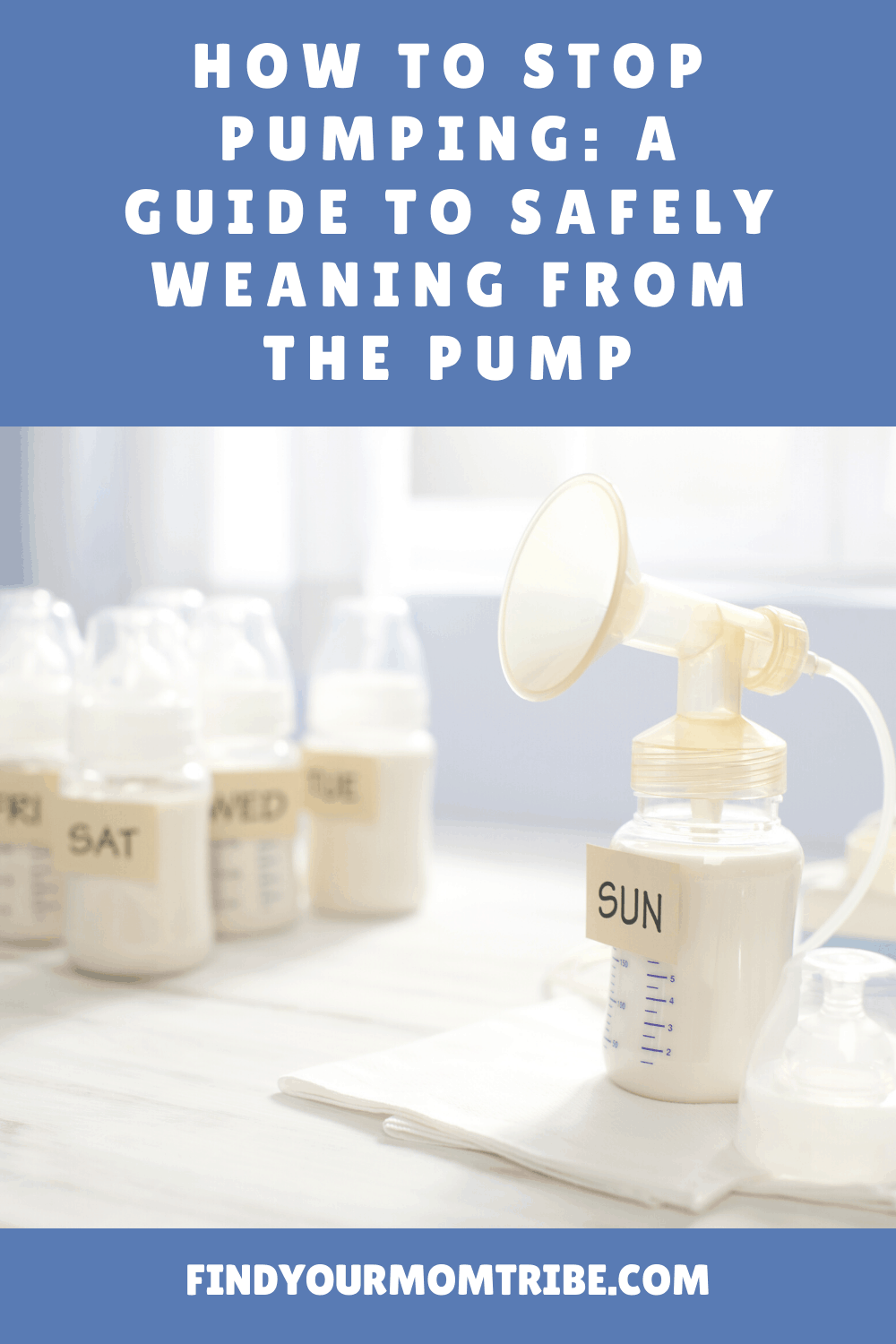
We love honesty! Find Your Mom Tribe is an Amazon Associate and we earn from qualifying purchases through affiliate links at no extra cost to you. Please see our full Amazon Affiliate disclosure for more information.

